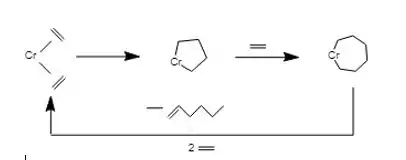Chromium(III) 2-ethylhexanoate
Chromium(III) 2-ethylhexanoate, C24H45CrO6, is a coordination complex of chromium and ethylhexanoate. In combination with 2,5-dimethylpyrrole it forms the Phillips selective ethylene trimerisation catalyst[2] (not to be confused with Phillips catalyst), used in the industrial production of linear alpha olefins, particularly 1-hexene or 1-octene.[3]

_2-ethylhexanoate.svg.png.webp) | |
| Names | |
|---|---|
| IUPAC name
Chromium(3+) 2-ethylhexanoate | |
| Other names
Chromium(3+) tris(2-ethylhexanoate) 2-Ethylhexanoic acid chromium(III) salt AR-1I2320 CID103012 | |
| Identifiers | |
3D model (JSmol) |
|
| ChemSpider | |
| ECHA InfoCard | 100.020.326 |
| EC Number |
|
PubChem CID |
|
CompTox Dashboard (EPA) |
|
| |
| |
| Properties | |
| C24H45CrO6 | |
| Molar mass | 481.6 g/mol |
| Density | 1.01 g/cm3 |
| soluble in mineral spirits | |
| Hazards | |
| Occupational safety and health (OHS/OSH): | |
Main hazards |
Harmful by inhalation, in contact with skin and if swallowed, Irritating to eyes, respiratory system and skin |
| GHS labelling: | |
  | |
| Warning | |
| H302, H312, H315, H317, H319, H361 | |
| P201, P202, P261, P264, P270, P272, P280, P281, P301+P312, P302+P352, P305+P351+P338, P308+P313, P312, P321, P322, P330, P332+P313, P333+P313, P337+P313, P362, P363, P405, P501 | |
| Flash point | 110 °C (230 °F; 383 K) |
| NIOSH (US health exposure limits): | |
PEL (Permissible) |
TWA 1 mg/m3[1] |
REL (Recommended) |
TWA 0.5 mg/m3[1] |
IDLH (Immediate danger) |
250 mg/m3[1] |
| Safety data sheet (SDS) | MSDS |
Except where otherwise noted, data are given for materials in their standard state (at 25 °C [77 °F], 100 kPa).
Infobox references | |
References
- NIOSH Pocket Guide to Chemical Hazards. "#0141". National Institute for Occupational Safety and Health (NIOSH).
- Naji-Rad, Ebtehal; Gimferrer, Martí; Bahri-Laleh, Naeimeh; Nekoomanesh-Haghighi, Mehdi; Jamjah, Roghieh; Poater, Albert (24 May 2018). "Exploring Basic Components Effect on the Catalytic Efficiency of Chevron-Phillips Catalyst in Ethylene Trimerization". Catalysts. 8 (6): 224. doi:10.3390/catal8060224. hdl:10256/15519.
- Agapie, Theodor (April 2011). "Selective ethylene oligomerization: Recent advances in chromium catalysis and mechanistic investigations". Coordination Chemistry Reviews. 255 (7–8): 861–880. doi:10.1016/j.ccr.2010.11.035.
This article is issued from Wikipedia. The text is licensed under Creative Commons - Attribution - Sharealike. Additional terms may apply for the media files.